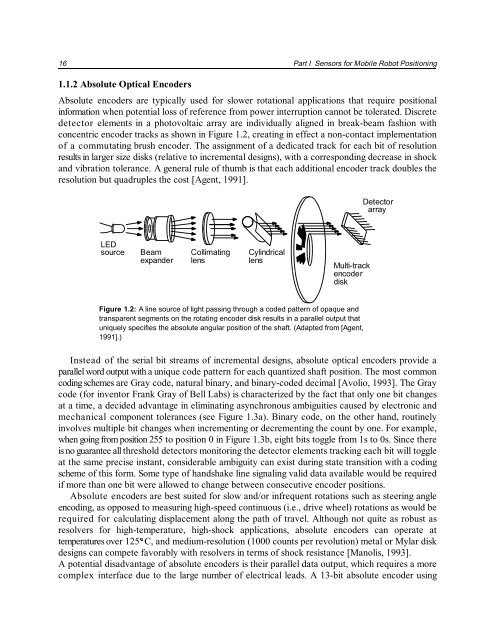Sensors and Methods for Mobile Robot Positioning
Sensors and Methods for Mobile Robot Positioning
Sensors and Methods for Mobile Robot Positioning
You also want an ePaper? Increase the reach of your titles
YUMPU automatically turns print PDFs into web optimized ePapers that Google loves.
16 Part I <strong>Sensors</strong> <strong>for</strong> <strong>Mobile</strong> <strong>Robot</strong> <strong>Positioning</strong><br />
1.1.2 Absolute Optical Encoders<br />
Absolute encoders are typically used <strong>for</strong> slower rotational applications that require positional<br />
in<strong>for</strong>mation when potential loss of reference from power interruption cannot be tolerated. Discrete<br />
detector elements in a photovoltaic array are individually aligned in break-beam fashion with<br />
concentric encoder tracks as shown in Figure 1.2, creating in effect a non-contact implementation<br />
of a commutating brush encoder. The assignment of a dedicated track <strong>for</strong> each bit of resolution<br />
results in larger size disks (relative to incremental designs), with a corresponding decrease in shock<br />
<strong>and</strong> vibration tolerance. A general rule of thumb is that each additional encoder track doubles the<br />
resolution but quadruples the cost [Agent, 1991].<br />
Detector<br />
array<br />
LED<br />
source<br />
Beam<br />
exp<strong>and</strong>er<br />
Collimating<br />
lens<br />
Cylindrical<br />
lens<br />
Multi-track<br />
encoder<br />
disk<br />
Figure 1.2: A line source of light passing through a coded pattern of opaque <strong>and</strong><br />
transparent segments on the rotating encoder disk results in a parallel output that<br />
uniquely specifies the absolute angular position of the shaft. (Adapted from [Agent,<br />
1991].)<br />
Instead of the serial bit streams of incremental designs, absolute optical encoders provide a<br />
parallel word output with a unique code pattern <strong>for</strong> each quantized shaft position. The most common<br />
coding schemes are Gray code, natural binary, <strong>and</strong> binary-coded decimal [Avolio, 1993]. The Gray<br />
code (<strong>for</strong> inventor Frank Gray of Bell Labs) is characterized by the fact that only one bit changes<br />
at a time, a decided advantage in eliminating asynchronous ambiguities caused by electronic <strong>and</strong><br />
mechanical component tolerances (see Figure 1.3a). Binary code, on the other h<strong>and</strong>, routinely<br />
involves multiple bit changes when incrementing or decrementing the count by one. For example,<br />
when going from position 255 to position 0 in Figure 1.3b, eight bits toggle from 1s to 0s. Since there<br />
is no guarantee all threshold detectors monitoring the detector elements tracking each bit will toggle<br />
at the same precise instant, considerable ambiguity can exist during state transition with a coding<br />
scheme of this <strong>for</strong>m. Some type of h<strong>and</strong>shake line signaling valid data available would be required<br />
if more than one bit were allowed to change between consecutive encoder positions.<br />
Absolute encoders are best suited <strong>for</strong> slow <strong>and</strong>/or infrequent rotations such as steering angle<br />
encoding, as opposed to measuring high-speed continuous (i.e., drive wheel) rotations as would be<br />
required <strong>for</strong> calculating displacement along the path of travel. Although not quite as robust as<br />
resolvers <strong>for</strong> high-temperature, high-shock applications, absolute encoders can operate at<br />
temperatures over 125(C, <strong>and</strong> medium-resolution (1000 counts per revolution) metal or Mylar disk<br />
designs can compete favorably with resolvers in terms of shock resistance [Manolis, 1993].<br />
A potential disadvantage of absolute encoders is their parallel data output, which requires a more<br />
complex interface due to the large number of electrical leads. A 13-bit absolute encoder using

















